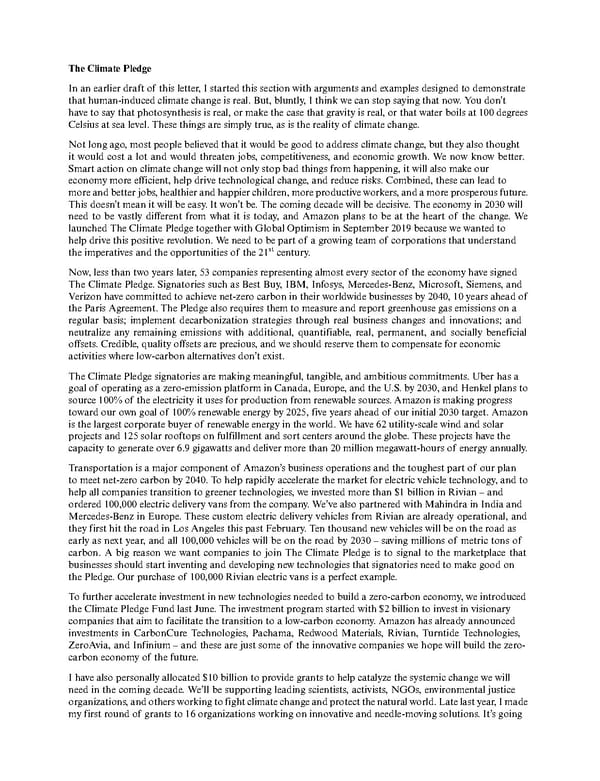TheClimatePledge In an earlier draft of this letter, I started this section with arguments and examples designed to demonstrate that human-induced climate change is real. But, bluntly, I think we can stop saying that now. You don’t have to say that photosynthesis is real, or make the case that gravity is real, or that water boils at 100 degrees Celsius at sea level. These things are simply true, as is the reality of climate change. Notlongago,mostpeoplebelievedthatitwouldbegoodtoaddressclimatechange,buttheyalsothought it would cost a lot and would threaten jobs, competitiveness, and economic growth. We now know better. Smartaction on climate change will not only stop bad things from happening, it will also make our economymoreefficient, help drive technological change, and reduce risks. Combined, these can lead to moreandbetterjobs,healthierandhappierchildren,moreproductiveworkers,andamoreprosperousfuture. This doesn’t mean it will be easy. It won’t be. The coming decade will be decisive. The economy in 2030 will need to be vastly different from what it is today, and Amazon plans to be at the heart of the change. We launched The Climate Pledge together with Global Optimism in September 2019 because we wanted to help drive this positive revolution. We need to be part of a growing team of corporations that understand st the imperatives and the opportunities of the 21 century. Now,less than two years later, 53 companies representing almost every sector of the economy have signed The Climate Pledge. Signatories such as Best Buy, IBM, Infosys, Mercedes-Benz, Microsoft, Siemens, and Verizon have committed to achieve net-zero carbon in their worldwide businesses by 2040, 10 years ahead of the Paris Agreement. The Pledge also requires them to measure and report greenhouse gas emissions on a regular basis; implement decarbonization strategies through real business changes and innovations; and neutralize any remaining emissions with additional, quantifiable, real, permanent, and socially beneficial offsets. Credible, quality offsets are precious, and we should reserve them to compensate for economic activities where low-carbon alternatives don’t exist. TheClimatePledgesignatories are making meaningful, tangible, and ambitious commitments. Uber has a goal of operating as a zero-emission platform in Canada, Europe, and the U.S. by 2030, and Henkel plans to source 100% of the electricity it uses for production from renewable sources. Amazon is making progress toward our own goal of 100% renewable energy by 2025, five years ahead of our initial 2030 target. Amazon is the largest corporate buyer of renewable energy in the world. We have 62 utility-scale wind and solar projects and 125 solar rooftops on fulfillment and sort centers around the globe. These projects have the capacity to generate over 6.9 gigawatts and deliver more than 20 million megawatt-hours of energy annually. Transportation is a major component of Amazon’s business operations and the toughest part of our plan to meet net-zero carbon by 2040. To help rapidly accelerate the market for electric vehicle technology, and to help all companies transition to greener technologies, we invested more than $1 billion in Rivian – and ordered 100,000 electric delivery vans from the company. We’ve also partnered with Mahindra in India and Mercedes-Benz in Europe. These custom electric delivery vehicles from Rivian are already operational, and they first hit the road in Los Angeles this past February. Ten thousand new vehicles will be on the road as early as next year, and all 100,000 vehicles will be on the road by 2030 – saving millions of metric tons of carbon. A big reason we want companies to join The Climate Pledge is to signal to the marketplace that businesses should start inventing and developing new technologies that signatories need to make good on the Pledge. Our purchase of 100,000 Rivian electric vans is a perfect example. Tofurther accelerate investment in new technologies needed to build a zero-carbon economy, we introduced the Climate Pledge Fund last June. The investment program started with $2 billion to invest in visionary companies that aim to facilitate the transition to a low-carbon economy. Amazon has already announced investments in CarbonCure Technologies, Pachama, Redwood Materials, Rivian, Turntide Technologies, ZeroAvia, and Infinium – and these are just some of the innovative companies we hope will build the zero- carbon economyof the future. I have also personally allocated $10 billion to provide grants to help catalyze the systemic change we will need in the coming decade. We’ll be supporting leading scientists, activists, NGOs, environmental justice organizations,andothersworkingtofightclimatechangeandprotectthenaturalworld.Latelastyear,Imade myfirst round of grants to 16 organizations working on innovative and needle-moving solutions. It’s going
 Amazon Shareholder Letters 1997-2020 Page 109 Page 111
Amazon Shareholder Letters 1997-2020 Page 109 Page 111